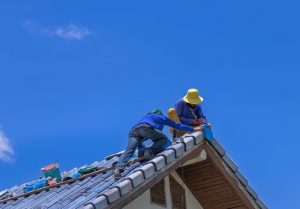If not addressed early, roof leaks can lead to extensive damage. While minor leaks may seem insignificant at first, they can cause serious issues like mold growth, weakened structural integrity, and costly repairs over time. Therefore, knowing how to detect roof leaks before they escalate is crucial to protecting your investment.
Read on to learn how to detect roof leaks before damage happens.
The Importance of Early Roof Leak Detection
Roof leaks are often subtle and can go unnoticed for extended periods. Water can travel a great distance from the actual leak site, making it difficult to locate the source. As water seeps into the home, it can damage insulation, wood framing, and drywall, leading to expensive repairs. By addressing the problem early, you can prevent damage and prioritize learning to detect leaks as part of regular maintenance.
Therefore, one way to stay ahead of the problem is by scheduling professional inspections. For example, working with specialists in roof leak repair can ensure any issues are identified and fixed before they worsen.
Common Causes of Roof Leaks
Understanding the common causes of roof leaks can help prevent them from happening in the first place. Here are some of the most frequent reasons:
- Damaged or Missing Shingles: Over time, shingles can become cracked, curled, or blown away, exposing the underlying materials to the elements.
- Clogged Gutters: When gutters are blocked, water can accumulate and back up under the roofline, leading to leaks.
- Improperly Sealed Roof Valleys: Roof valleys, where two sloping sections meet, are particularly vulnerable to leaks if not sealed correctly.
- Flashing Issues: Flashing, the material used to protect joints and seams on a roof, can crack or corrode, allowing water to seep through.
- Ice Dams: In colder climates, ice dams can form, forcing water to back up under the shingles and into the home.
- Age of the Roof: Older roofs are more susceptible to leaks due to wear and tear. Regular inspections become more critical as a roof nears the end of its lifespan.
By knowing these reasons, you can find ways to detect roof leaks more effectively and prevent simple problems from escalating.
Signs of a Roof Leak
Detecting roof leaks before they cause extensive damage requires vigilance. Hence, you should be on the lookout for the following common warning signs:
- Water Stains on Ceilings or Walls: One of the most apparent indicators of a roof leak is a water stain. These stains appear as discolored, brownish rings on ceilings or walls and can be irregularly shaped.
- Musty Smells: A persistent musty odor in the home may signal mold or mildew growth caused by moisture. Even if no visible signs of water are present, a roof leak could be the underlying cause.
- Dripping Water or Puddles: The leak has become significant if water is actively dripping from the ceiling or pooling on the floor. However, this usually indicates that the problem has been ongoing.
- Peeling Paint or Wallpaper: Moisture from a roof leak can cause paint to bubble and peel or wallpaper to separate from the wall. These visual clues may point to hidden water damage.
- Cracked or Warped Shingles: From the outside, examine the roof for cracked or warped shingles, which can be an entry point for water. Regular roof inspections can help catch these issues early.
- Sagging Roof Deck: A roof that appears to be sagging or dipping in certain areas may indicate water damage to the underlying structure.
By understanding these warning signs, you can implement measures to prevent leaks from causing severe damage to your home.
How To Inspect Your Roof for Leaks

Regular inspections are key to preventing roof leaks from becoming a major issue. Here are steps you can take to identify potential leaks before they become problematic:
Visual Inspection from the Ground
Start by walking around the home’s perimeter and inspecting the roof from the ground. Look for visible signs of damage such as missing or damaged shingles, clogged gutters, or gaps in flashing.
Check the Attic
The attic is often the first place to show signs of a roof leak. Using a flashlight, inspect the attic during daylight hours, and look for any beams of light coming through the roof. Also, check for moisture or mold growth in the insulation.
Examine Roof Valleys and Flashing
Since valleys and flashing are common sources of leaks, give these areas extra attention. Inspect them and ensure that the metal flashing is intact and properly sealed.
Inspect the Gutters
Make sure gutters are free of debris, allowing water to flow away from the roof. Clogged gutters can cause water to back up and seep under the roof’s edge.
Look for Granule Loss
If you notice a buildup of granules from shingles in your gutters, this may be a sign that the roof is deteriorating and more vulnerable to leaks.
Professional Roof Inspections
While you can perform basic roof inspections, it’s essential to schedule regular professional assessments to catch problems that may not be easily visible. Professionals are trained to spot subtle signs of roof leaks that the untrained eye might miss. Regular inspections, ideally once or twice a year, can help extend the life of a roof and prevent expensive repairs down the line.
Furthermore, professional roofing contractors, like those specializing in fixing roof leaks, can also employ advanced techniques such as infrared scanning to detect moisture within the roof’s structure and identify potential issues long before they become visible.
Final Thoughts
Detecting roof leaks before they cause significant damage requires vigilance and regular maintenance. By keeping the information mentioned above in mind, you can prevent minor issues from escalating into major problems. Lastly, partnering with professionals for roof leak repair ensures that issues are addressed quickly and effectively, safeguarding the home from costly damage.

Recent Comments